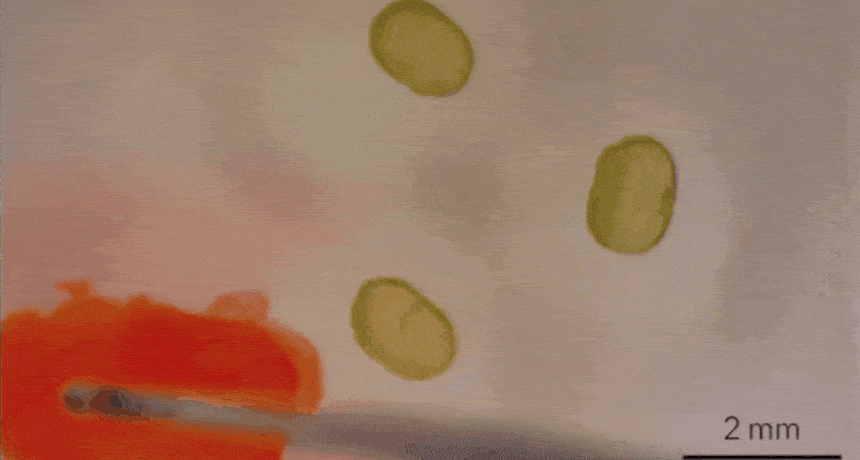Tiny new magnets are not only squishy but also liquid
The movement of external magnets might help control robots and more

Three permanently magnetized liquid droplets floating in oil. As they spin in response to a rotating magnetic field, their activity wraps orange dye around themselves.
X. Liu et al/Science 2019
The rules for what makes a good magnet may not be as rigid as scientists once thought. Researchers have just created liquid droplets that behave like tiny bar magnets.
Magnets that produce a permanent magnetic field typically are made from solids, such as iron. Like tiny bar magnets, each of their atoms has its own north and south poles. In a standard magnet (like the one holding messages on a kitchen refrigerator), those magnetic poles all point in the same direction.
Some liquids contain particles that can become magnetized when placed in a magnetic field. However, the orientation of their magnetic poles will tend to get jumbled as soon as the magnetic field goes away. At this point, the liquid no longer is magnetic.
Thomas Russell is a polymer scientist at the University of Massachusetts Amherst. He and his colleagues added certain polymers to the droplets’ recipe. This allowed them to make permanently magnetized droplets. They described how they did it July 19 in Science.
Such magnetic drops could be used to build soft robots. They might also be used in ingested drug capsules. Later, doctors could use magnets to bring the medicine to targeted cells. Applying an external magnetic field might control many types of liquid devices made this way, Russell suggests — almost like waving Harry Potter’s wand.
Science News/YouTube
How they did it
Most solid magnets are made from iron. These new liquid magnets are, too. Russell and his team made a watery solution containing iron-oxide nanoparticles. Then they lowered millimeter-sized droplets of the solution into oil. Polymers in the oil pulled many of the nanoparticles to the droplets’ surfaces, pinning them there. This formed a densely packed shell of nanoparticles around each droplet.
Exposing a droplet to a magnetic field forces the magnetic poles of its nanoparticles to point in the same direction. Nanoparticles on the droplet’s surface are crowded so closely that when the magnetic field shuts off, their magnetic poles can’t fall out of alignment, the team found.
What’s more, the collective magnetism of all of those surface particles is strong. It is strong enough to keep aligned the poles in all of the other nanoparticles floating freely throughout the rest of the droplet. “So the whole droplet behaves like a solid magnet,” says study coauthor Xubo Liu. He’s a materials scientist in China. He works at Beijing University of Chemical Technology.
Like bar magnets, the droplets’ opposite poles attract and their matching poles repel. So dividing up a single magnetized droplet produces smaller pieces. Each of these has its own north and south poles.
The scientists created simple round and cylindrical droplets. However, Liu notes, 3-D printing or molding techniques could create liquid magnets with more complex forms.
Liquid magnets could help soft robots get around, says Rémi Dreyfus. He’s a chemical physicist with CNRS. That’s the French national research agency. Right now Dreyfus is working at a research lab in Bristol, Pa. It is run jointly by CNRS, a university and a specialty chemicals company.
Dreyfus has worked on micromachines. Some microrobots move using inflatable air pouches or electric currents. But such bots might instead be injected with a magnetic liquid, he says. Then they could be controlled remotely with magnetic fields.
The new droplets might also be combined to create new types of materials, he says. Dreyfus mentions a few possibilities in a commentary that appears in the same issue of Science. He says, “I’m sure people will have many ideas” for how to put such ultrasoft magnets to work.







